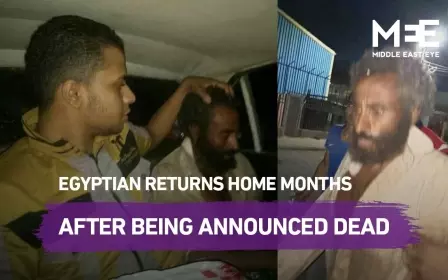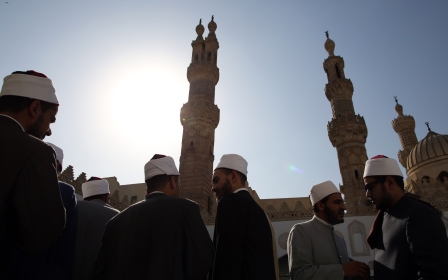Destruction of tombs in Cairo's City of the Dead leaves the living furious

Cairo's vast necropolis is a sacred place for Egyptians. Also known as the City of the Dead, it contains tombs that date back to the time of the Mamluks, who ruled Egypt for over 250 years before the Ottoman conquest in 1517, as well as the shrines, mosques and mausoleums of early Islamic leaders such as Imam al-Shafi.
But Egypt's authorities are causing outrage and fury by carving right through it, in the process demolishing many tombs and the remains of Egypt's precious Islamic heritage in order to build a flyover.
The flyover, authorities insist, will reduce traffic congestion in the western part of Cairo.
"This area contains the tombs of people who played very important roles in Egypt's history," Gamal Abdel Rahim, a professor of Islamic history at Cairo University, told Middle East Eye.
The necropolis is located only a few kilometres away from the al-Azhar mosque, the heart of Fatimid Cairo and the Khan al-Khalili bazaar at the historic centre of Islamic Cairo.
The flyover is one of dozens of road and infrastructure projects implemented by the authorities to improve the quality of the roads and reduce travel time, especially in Cairo, a city of 21 million people.
For the moment, Cairo is the pulsating heart of Egypt's economic and civic life. But it is due to be replaced as the country's administrative capital by a gigantic new city - slated to be almost as big as Singapore, with housing for over 6 million people - which is being built from scratch nearly 30 miles to the east of Cairo.
The road projects carried out in Egypt over the past few years have seen the country move up to 29th position on the Road Quality Indicator in 2019, from 110th in 2015.
These projects contained close to 5,000km of new roads and dozens of flyovers and bridges.
The flyover to be established in western Cairo is called el-Fardous. It will connect the southern part of the Egyptian capital with its western part, passing right through the City of the Dead.
"The authorities should have conducted enough studies on the area before starting the demolition of the tombs," Soheir Hawas, a professor of architectural engineering at Cairo University, told MEE. "It could have easily chosen another location for the flyover to protect the ancient buildings of the area."
Photos shared by social media users of government bulldozers razing tombs in al-Ghafir cemetery, which is part of the necropolis, caused anger among Egyptians and sparked calls for the protection of the nation's monuments.
Protesters have also launched the "No to the demolition of Egypt's monuments" hashtag to draw attention to what is going on in the City of the Dead.
Government denial
Government officials, however, say the tombs torn down were neither historical nor registered as monuments.
"They look old, but in fact they are not registered as Islamic antiquities," Mostafa Waziri, the head of the Supreme Council of Antiquities, the section of the Ministry of Tourism and Antiquities responsible for the protection of the nation's monuments, told the Saudi channel MBC on 21 July. "There are regulations for the registration of antiquities."
'It was the guard of the tomb who told us about [the demolition]. This did not give us enough time to remove the remains to another place before the demolition'
- son of late Egyptian novelist Ihsan Abdel Quddous
Waziri said objects cannot be registered as antiquities before they are at least a century old.
Abdel Rahim, the Islamic history professor at Cairo University, had to personally intervene last week to prevent the demolition of the tomb of Shivakiar Ibrahim, the first wife of King Fuad, a member of the Muhammad Ali dynasty who became the sultan of Egypt in 1917.
Historic Islamic Cairo was placed on Unesco's World Heritage list in 1979.
The tombs knocked down include those of important people who helped shape Egypt's history over the last century.
These include the tomb of Muhammad Ahmad Abbud Pasha, a businessman and stakeholder in Banque Misr, Egypt's oldest bank, who died in 1963. By the time of his death, Abbud Pasha had been one of the wealthiest men, not only in Egypt, but in the whole region.
Apart from the burial chamber, his tomb was made up of a large courtyard that included a garden that contained flowers and decades-old trees.
The tombs also included that belonging to Hassan Sabry Pasha, a former prime minister who died in 1940, and the tombs of Ihsan Abdel Quddous, a renowned Egyptian novelist who died in 1990, and the famous comedy actor Fouad el-Mohandes, who died in 2006.
Most of the tombs erased contained engravings and drawings that recalled Egypt's artistry as well as history. Many believe the tombs were so beautiful that they could have become tourist attractions.
Lack of knowledge
Waziri said most of the tombs knocked down in the area date back to the 1920s and 1930s. He added that he had ordered the formation of a panel to investigate the history of the tombs in order to decide whether they were eligible to be registered as antiquities.
Some of the Mamluk tombs had apparently not been registered as antiquities.
On 3 April 2017, Mohamed Abou Saeda, the head of the National Organisation for Urban Harmony - which is partly responsible for the design of Egyptian cities and surveying buildings with architectural value - said his organisation was still surveying the Mamluk tombs. The aim of the survey, Abou Saeda said, was to create a major database of these tombs.
"The registration of the tombs of people who played important roles in Egypt's history will help us protect this heritage and history," a local newspaper quoted Abou Saeda as saying.
However, some of the historical tombs seem to have been pulled down already before Egypt'sofficials realised their full value.
And some demolitions have not only affected the dead, but also those they leave behind, who have had to see their relatives' resting places bulldozed.
One of the photos shared by social media users in recent days was particularly poignant.
It showed a man standing next to the erased tomb of his parents and daughter and raising his hands in prayer.
He was one of many who were shocked at the news that their loved ones' tombs had been levelled.
Most of these people say they had not been alerted by the authorities about the planned destruction.
Mohamed Abdel Quddous, a well-known journalist and the son of renowned novelist Ihsan Abdel Quddous, said his family was informed about the demolition of parts of his father's tomb only two weeks earlier.
"It was the guard of the tomb who told us about this," Abdel Quddous told MEE. "This did not give us enough time to remove the remains of our dead relatives to another place before the demolition."
The next time Abdel Quddous visits his father's tomb, he now knows that he will see nothing but ruins.
This article is available in French on Middle East Eye French edition.
Middle East Eye delivers independent and unrivalled coverage and analysis of the Middle East, North Africa and beyond. To learn more about republishing this content and the associated fees, please fill out this form. More about MEE can be found here.








